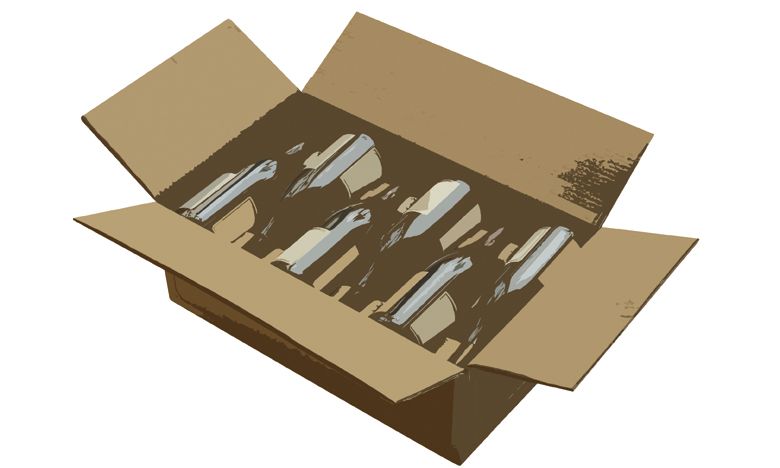Wine Without Borders
Complicated shipping compliance hinders country’s wine market

By Natasha Bailey
Alcohol, especially wine, was booming before 1920. Meanwhile, phylloxera, a microscopic louse that lives on and eats roots of grapes, was making its way through Europe at the time, utterly devastating vineyards and the continent’s wine market. So it is no surprise that American winemakers were excited for the opportunity to compensate for Europe’s loss and finally wedge their glass into the world wine market. But, the temperance movement of the late 19th and early 20th centuries loomed, eventually shattering the blooming American wine industry with 13 years of Prohibition.
Wineries were shut down, boarded up or demolished. Acres of vineyards abandoned, sitting dormant or ripped up from the root. Years of work, family’s livelihoods and millions of dollars, all down the drain. However, some did not bend to the will of the law: bootleggers and the church. Bootleggers mainly focused on the illegal distribution of hard liquor, while churches needed wine for their ceremonies; thus, a few select wineries were legally allowed to produce.
The year 1933 marked the end of Prohibition, and while wine production was legal once again, the industry’s suffering continued. “When they repealed Prohibition, they put the governing of alcohol back into the state’s hands. That allowed each state to have its own set of laws,” says Jackie Crawford, the managing member of Red Hill’s Compliance Services. Eighty-six years later, many states have the same laws in place.
“I don’t think [change] is high on their priorities,” says Linda Arnold, Yamhill Valley Vineyards’ tasting room manager, events coordinator and compliance manager. Her job requires her to interact directly with a frustrating and outdated alcohol distribution system that can be challenging because of the shipping laws of each state. She says, “It goes from ‘they don’t care’ — the information probably just sits on their desks — to ‘they have 50 people working in the compliance room and you’ve probably done something wrong.’” The states’ regulations are so complicated Arnold received training with compliance software company ShipCompliant, a reasonable solution for family-owned wine businesses.
The drastic differentiation is echoed by Crawford, “When you sit down and start looking at all the [states’] rules and all the laws, and all the requirements, it can get mind-boggling. That’s why I started [Red Hill’s Compliance Services]. I was Oregon Wine Services’ compliance manager for a couple years, and while I was there, it became very obvious Oregon needed help, somebody who could put a business card in their back pocket and pull it out when they had questions.”
The variation among all the states is not the only difficulty the two women deal with; Arnold says, “The most frustrating aspect for me is that the states, when you call for any information, send you through a lot of hoops to get you to the right person.” Basically, “One hand does not know what the other hand is doing.” The communication of rudimentary information to sales associates is one of the major pitfalls of state-legislated alcohol laws. She adds, “Half the people you call don’t know what you’re talking about!”
“Most all the states operate under what’s called a three-tier business model, and the three-tier goes: supplier, distributor, retailer, and the end user is the consumer,” explains Crawford. But, of course, this system isn’t the same for each state; for example, Kansas operates a four-tier system. She adds, “There are only a couple of states that even allow wineries to sell directly to retailers; Oregon is one, but there aren’t many.”
The three-tier system forces any producers wishing to sell out of state to bend over backwards and work with a constantly shrinking pool of distributors. Ultimately, the current three-tier system and states’ stringent restrictions on wine sales is detrimental for boutique wine producers and consumers nationally, limiting American citizens hoping to expand their cellars and palates. Customers truly have only a small selection of wine they are allowed to view, let alone buy.
How can we fix it? Well, there isn’t really a straightforward answer.
“It would just be easy if all states did the same thing, so you wouldn’t have to keep up with everything that’s changing in each state all the time, and thus possibly have the tendency to get in trouble,” says Arnold, “I would think that there could be a federal law that takes care of all the states.”
But Crawford views it differently, “I think any time you get the feds involved, it gets sticky, and liquor laws are already sticky enough. It is kind of a double-edged sword.” Without federal regulation, the laws from state to state are inconsistent and difficult to work with, however, the last time the federal government got heavily involved, Prohibition occurred. “It would be nice if we had an industry standard, but what would make it even nicer is if it was an independent industry standard.”
Fortunately, there is a small, but positive, movement already occurring in the wine industry, Crawford says, “There are more states that are opening self-distribution, such as Connecticut, Ohio and Illinois. They are some of the strictest states in the country that have decided that they are going to allow small farm wineries the ability to self-distribute. I think we are going to be seeing that more and more.”
So, while our current system is haphazard, difficult, intimidating and in the market for repair, there are steps states’ legislators can start taking. As an industry that struggles nationally, it is time to start pushing for change and correcting a wrong history has yet to recover from so that winemakers and buyers can enjoy wine without borders.










